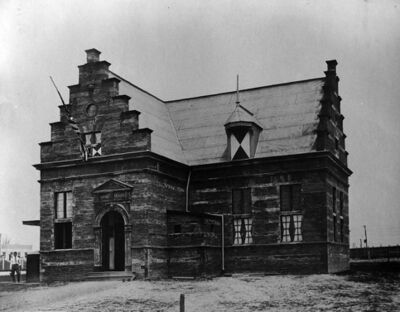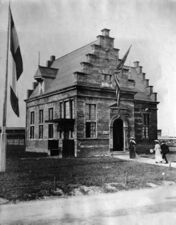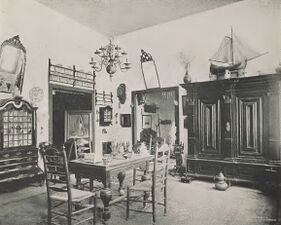Holland: Difference between revisions
No edit summary |
No edit summary |
||
| Line 18: | Line 18: | ||
| child_entry = | | child_entry = | ||
| opening_day = | | opening_day = | ||
| dedication_day = | | dedication_day = May 28, 1904 | ||
| special_day = | | special_day = | ||
| other = | | other = | ||
Latest revision as of 05:35, 26 September 2024
 | |
| Location | Place of Nations |
|---|---|
| No. of Buildings | 1 |
| Construction | |
| Construction Cost | $5,000 ($150,796 in 2021) |
| Dates | |
| Dedication Day | May 28, 1904 |
| Architecture | |
| Dimensions | 40' x 50' |
Holland's small pavilion was on the site formerly allotted to Russia on the Place of Nations and abandoned by that country when war had begun with Japan. On three sides steep-pitched Dutch gables with corbie-steps on the slopes topped the building.
Description[edit | edit source]
A typical Dutch garden surrounded the structure.
While not an exact copy of the home of Rembrandt, the building is a perfect piece of sixteenth century domestic architecture, and is a curio shop of old furniture. Delft pottery and silver. In one of the rooms is a painting eighteen feet long by twelve wide, a reproduction of the most famous of all Rembrandt's paintings, the one that has been called "The Night Watch," copied by Hendrik Kleyn, which was in the State Museum at Amsterdam at the time. An admission fee was charged to view the picture.
The interior of the building of Holland presented a collection of furniture, tableware and brie a brae, all more than a century old. In one corner was an immense wardrobe of light colored walnut, with Dutch mountings in metal. This wardrobe was made some time before 1750. A model ship, of an Old Frieschen was on top of the wardrobe. In front of the wardrobe stood a hammered brass water kettle. The chairs around the table in the center of the room were taken from an old church. The table is nearly 200 years old. On the side of the room opposite the wardrobe is a cabinet filled with Delft china, 150 years old. Some of these samples of old Dutch ware bear the famous name of the Duyn Pottery. They were made as early as 1640. A candle chandelier hanging in the center of the room, is more than three centuries old. In one corner is a little Dutch spinning wheel. Through the doorway can be seen a chaise intended for children, to be drawn by a goat. The collection was arranged to represent the living room of an old Dutch mansion of the year 1750.
Gallery[edit | edit source]
-
Exterior
-
Interior


